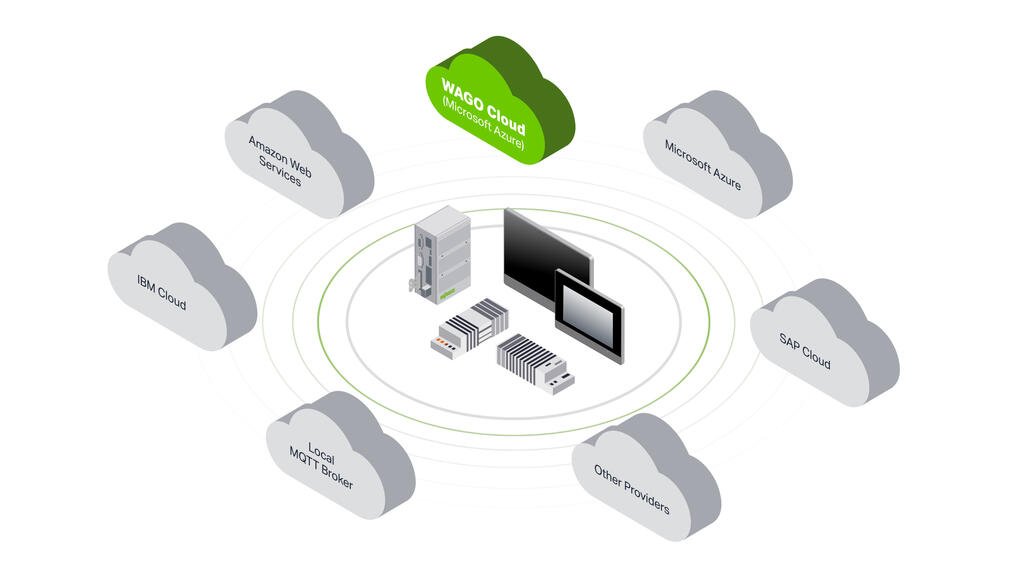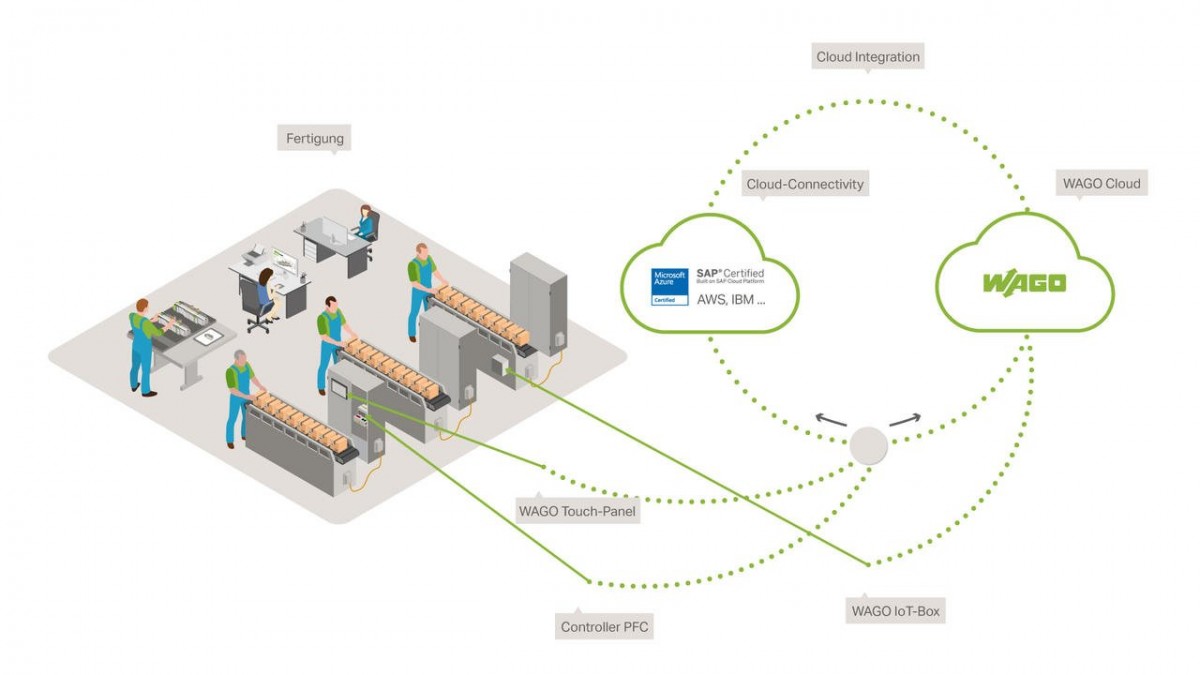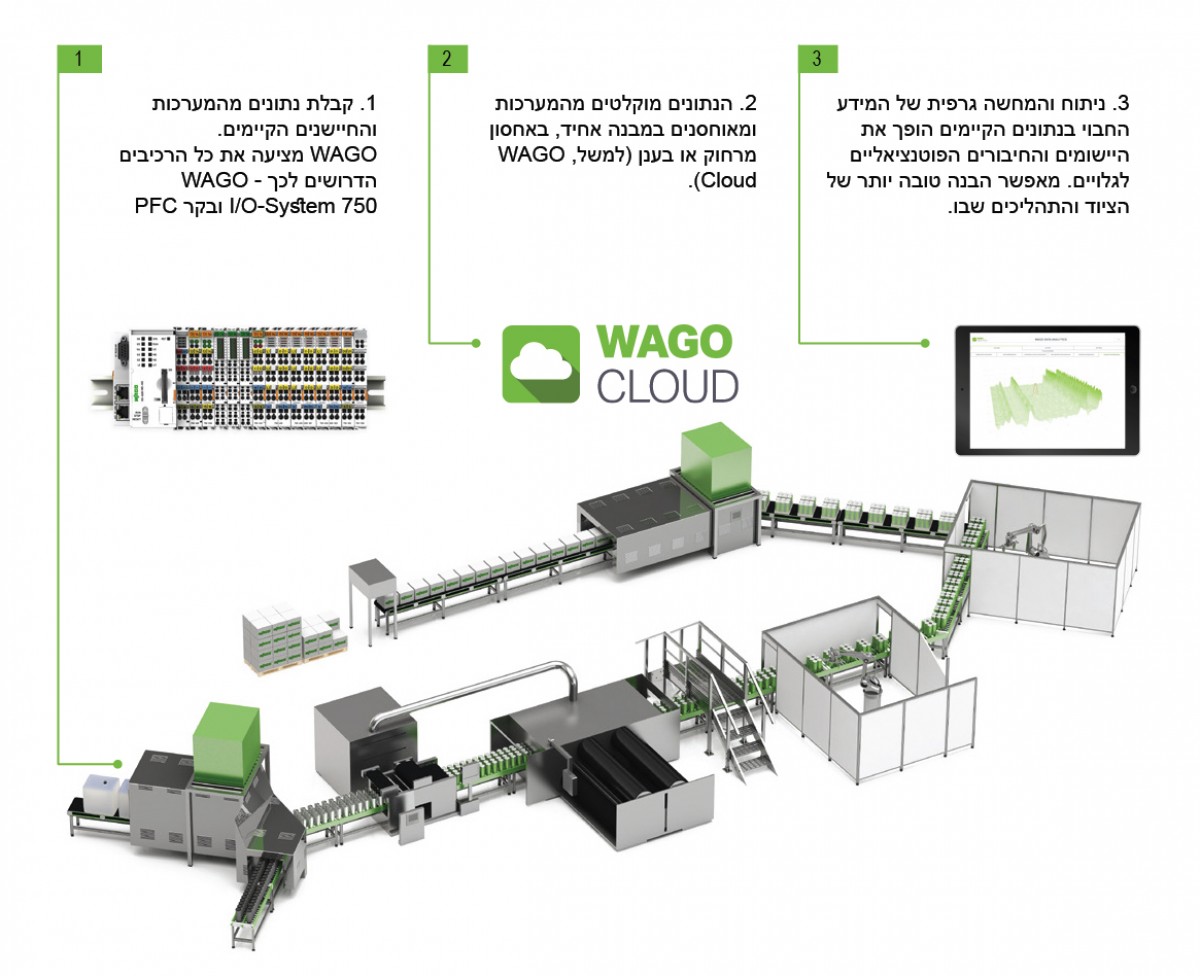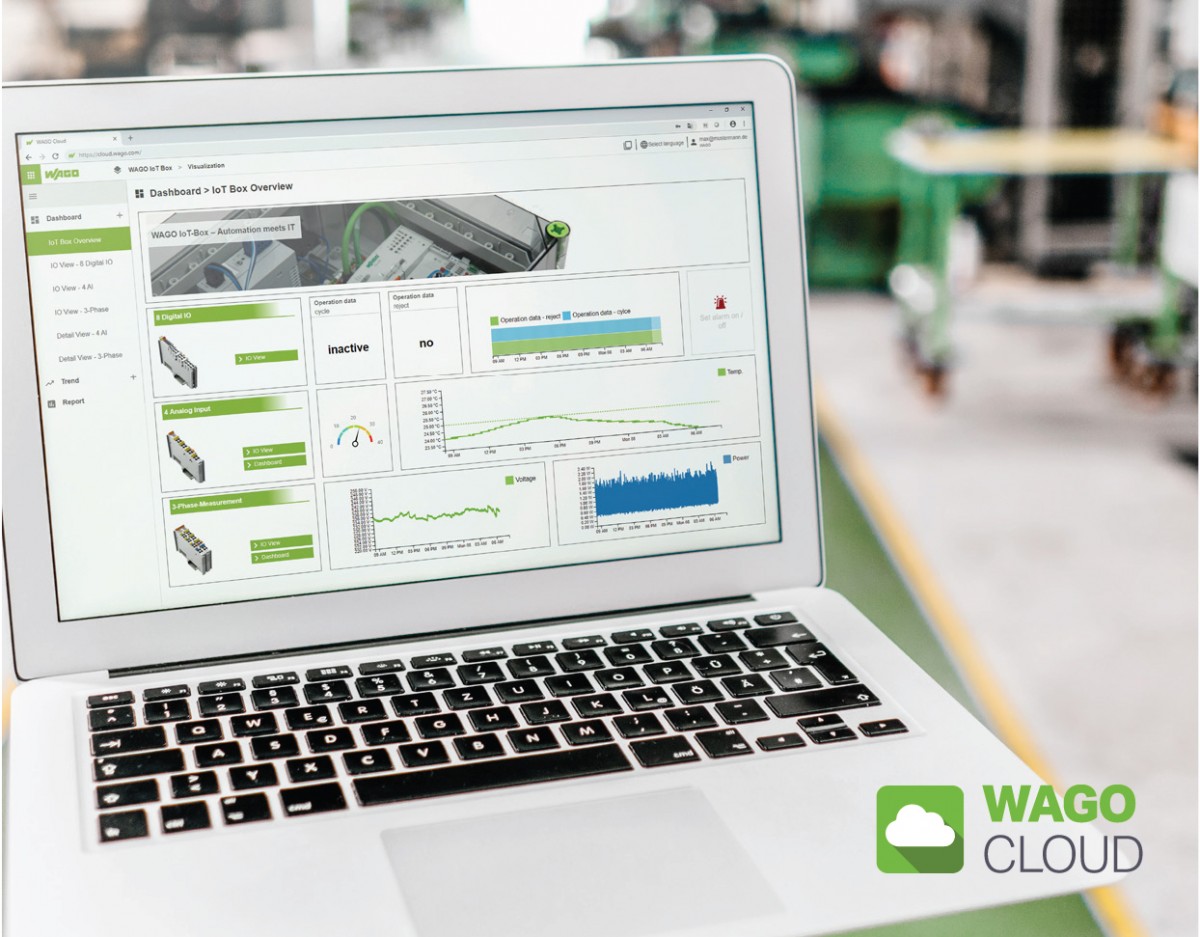IoT Cloud - Not Pie in the Sky!
One of the most important factors, when using automation systems in cloud computing, is the availability of all the information at any time and from anywhere. The ability to securely log in to the web browser set up, control, monitor the system easily, and alert and respond quickly to exceptional cases. Read the new article on the WAGO Cloud system, published in the latest NEWTECH magazine.
To read the original article in Hebrew on the NEWTECH website click HERE
The development of the Internet of Things (IoT) and its integration in our industry and smart cities has changed the way we work and live, it has enriched our society. The tremendous development of communication and sensing technologies has created an environment in which many “things” are interlinked, providing a smarter environment, improving our lives. This connectivity between all these things is called the Internet of Things (IoT). IoT technology continues to develop and IoT components are continually getting smarter through ever-increasing processing power, storage capacity and communication speeds. The IoT devices include cameras, sensors, ID badges, RFID, drones, mobile phones, and many others. These devices have the potential to communicate and work together to achieve shared goals. With these kinds of components and technologies, IoT devices are able to provide a range of real-time monitoring applications, such as environmental monitoring, electronic health services, transport autonomy, industry digitalization and automation, home automation, and so forth.
IoT components can collect and provide huge quantities of data through advanced communication technologies - data that can be analyzed to make informed decisions. The huge quantities of heterogeneous data, which are collected from various devices in smart environments, require cloud computing services, and therefore cloud services form a critical technology for the physical infrastructure of a smart environment. To deploy a smart environment, a combination of a distributed cloud and distributed open code is required. Through Big Data analysis, (distributed data arriving from multiple sources), it is possible to implement smart learning methods, thereby obtaining a precise estimate of energy efficiency and the ways it can be reduced even further in order to meet the system requirements.
The challenge in the vast quantities of data being accumulated is the forecasting and estimating the energy necessary to analyze the data collected. There is a need for quick analysis of Big Data. If the volume of the Big Data increases, this will significantly increase the cost and resources required for the analysis. IoT’s Big Data requirements need storage capacity and broadband for transmission in order to enable IoT anywhere. Data storage on the cloud enables waving on the bandwidth of cellular infrastructures, in that it makes the sending of overlapping or duplicate data redundant, thereby reducing the costs of the connections for the IoT devices to the network.
There are great advantages to the use of IoT technologies to process and transmit. Among these advantages are the savings on natural resources, minimizing the technological impact on the environment and on human health, and reducing costs. Thus for example, it is possible to reduce electricity consumption in organizations, improve the quality of life in smart cities, and contribute toward turning the world into a greener place through reducing the dangers of pollution, through more sustainable manufacturing and collectively to transform the world into a safer place to live in. Other examples are the improvement of public transformation, reducing traffic congestion, creation of economical municipal services, safeguarding citizens’ safety and health, reducing energy consumption, improving monitoring systems, and reducing pollution. In addition it will be possible to achieve other environmental improvements - for example, energy consumption, carbon emissions, energy savings, commerce, carbon reduction, footprint reduction, and so forth. All this through the transfer of data from IoT devices, through the collection of large quantities of information from them and presenting the information in usage protocols, and subsequently designing energy-efficient policies. In fact, IoT components sometimes implement a global environmental communication network, and an invisible computing environment built in accordance with smart sensors, controllers, cameras, software, databases and data centers in smart cities (Almalki, F.A., Alsamhi, S.H., Sahal, R. et al. , 2021)
 WAGO Cloud Connectivity
WAGO Cloud Connectivity
 Wago Cloude Integration at production site as well as the office
Wago Cloude Integration at production site as well as the office
How are IoT and cloud services connected?
The simple explanation of the connection between IoT, Big Data and the cloud is: IoT is the data source, Big Data is an analytical data platform, and cloud computing is the location for the storage, scale and access speed. Cloud computing technology, with its unlimited properties and services, is considered to be the best infrastructure for IoT systems. Nowadays most of the IoT controllers which are used for sensing, monitoring and management - store their data in the cloud.
Cloud computing is an economical solution, since it requires no on-site infrastructure for storage, processing and analysis. The connection between IoT, Big Data and cloud computing creates many opportunities for businesses to harness exponential growth. All of these technologies have a positive effect on economies and on societies. This can easily be seen in the agriculture sector: the existence of smart, cloud-based applications and models helps farmers control their crops. Through data collection and analysis, they are able to provide a better response to problems caused by weather or diseases in various crops. Thus, in agriculture too, the IoT applications result in increased production and reduced losses (M. Tawalbeh, M. Quwaider & L. A. Tawalbeh, 2021).
IoT and cloud systems - not just for IT personnel!
The use of cloud services for IoT systems is not necessarily the exclusive domain of IT personnel! The German company WAGO has developed cloud services (Claud), and offers the user a complete IoT system which, combined with PFC controllers and control panels, makes it easier to connect to machines and systems, thereby enabling cloud-based operation and control of buildings and structure management. The WAGO CLOUD system enables the user to collect and analyze the data from various machines and to easily monitor WAGO controllers and their data and applications. All this is done so easily and simply that no IT experience or resources are needed! Through connecting WAGO controllers to the WAGO cloud, which is done within minutes, it then becomes possible to allocate them to the customer, to the site and the system, to track connection parameters and to process data. There are also alarm and alert functions which enable the user to respond quickly to irregular occurrences.
The WAGO CLOUD system enables focused imaging and comparison of the user’s computer and system data, as well as presenting the measured data over time graphically, and to create a graphic representation of the locations of the controllers and their connection statuses.
The current WAGO system is already future-ready! The communication between PFC controllers and cloud providers is done via an MQTT protocol and is encrypted using TLS 1.2. Cloud connection data are defined through a web-based management (WBM) system. WAGO’s engineering software, e!COCKPIT contains libraries suitable for specifying the variables to be sent to the cloud through the PLC software, which enables the PLC programmer to retain full control. Information can also be sent from the controller, for example start/stop, connection state and information about the device, to the cloud solution through cloud connectivity or to distribute it through an MQTT mediator.
 Automation Chain
Automation Chain
Remote Access
The WAGO CLOUD system enables the user to obtain access to local configurations and images through remote access without having to time-consumingly configure IT infrastructure! The Internet browser can be used to easily define, control and monitor the system remotely. The access, of course, is under authorization, where there are various authorization levels.
Remote Access
The WAGO CLOUD system enables the user to obtain access to local configurations and images through remote access without having to time-consumingly configure IT infrastructure! The Internet browser can be used to easily define, control and monitor the system remotely. The access, of course, is under authorization, where there are various authorization levels.
Consistent performance and high security!
The WAGO Cloud system is based on the cloud platform, which is based on Microsoft Azure and it can also be scaled up in terms of computing power, data storage, transactions, functions, availability and security standards, all of which provide this platform with numerous advantages, which include:
• “Always Updated” - each controller requires software updates to ensure full availability and zero design and/or security malfunctions. Software updates are done remotely. Through the WAGO controllers, it takes just a few mouse clicks to distribute an existing application to multiple controllers and to choose between automatic firmware updates from the cloud or manually, via the website.
• High availability of cloud services (over 99%)
• Hosting in the Microsoft data center.
• High security - compliance with security standards, which are verified (through penetration testing), among others through TÜV Rheinland I-Secure GmbH.
• Centralized monitoring and management of IoT devices - display of connected controllers and relevant connection details
• User-friendly: all of he functions can be viewed at a glance thanks to the intuitive application structure
• Simple user-based or role-based allocations
• Centralized data collection and analysis for greater transparency and for process optimization
• Alarming through automatic identification of alarms and error messages
• Remote diagnostics and maintenance of all the connected IoT devices
• Simple, flexible data export through a RESTful API interface to third-party software.
• Personalized customization of the dashboard with a variety of data display options;
• Straightforward pricing through a simple license points model - you only pay for the applications you choose
 WAGO Dashboard – IoT Box Overview
WAGO Dashboard – IoT Box Overview
WAGO provides both the hardware and the software, thereby providing a one-stop shop of the highest quality, with the highest possible security, fulfilling the customer’s every requirement. Thus for example, the German Avacon Natur GmbH company, the provider of energy services and the operator of CHP plants, heating networks and heating service systems, uses WAGO Cloud for analyzing data from its energy systems and heating networks. Lars Baumann, asset management group manager at Avacon Natur GmbH, says: “The WAGO Cloud solution, which has been developed for us, is a customized solution that still allows us unlimited hierarchy". The cloud stores all of the measurement data and provides an interface to Avacon Natur’s energy data management system, which also operates on the Microsoft Azure platform. The PFC200 WAGO controller collects measurement data (heat quantities, flow rates, supply/return temperatures) and it also collects motor data from CHP plants, and thereby both the employees at the company headquarters and the local service technicians are able to Supervise the energy systems. The WAGO CLOUD system is your connection to the digital world of IoT!
WAGO is represented in Israel by Comtel Israel Electronic Solutions Ltd. (Comtel Israel). 09-7677240 – sales@comtel.co.il – www.comtel.co.il




